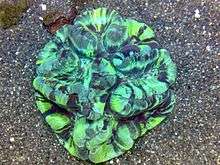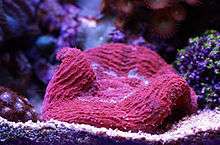Open brain coral
| Open brain coral | |
|---|---|
 | |
| Green open brain coral | |
| Scientific classification | |
| Kingdom: | Animalia |
| Phylum: | Cnidaria |
| Class: | Anthozoa |
| Order: | Scleractinia |
| Family: | Trachyphylliidae |
| Genus: | Trachyphyllia |
| Species: | T. geoffroyi |
| Binomial name | |
| Trachyphyllia geoffroyi Audouin, 1826[1] | |
| Synonyms | |
|
Trachyphyllia radiata | |
The open brain corals, Trachyphyllia geoffroyi, are just one of thousands of classifications of coral. They are named as such due to their resemblance to an inverted animal brain as seen by the human eye. As the name also suggests, the open brain corals are related to the many other species of brain corals found in shallow warm-water coral reefs in all the world's oceans. The different specific sub-species come in an array of colors ranging from opaque, blue, green, red, pink and brown.[2]
Habitat
Open brain corals are found in the warm, shallow waters of the tropics.[3] Due to the symbiotic relationship corals have with zooxanthellae (for more information, see "symbiotic relationship" section), corals and therefore coral reefs, thrive in clear, shallow waters to allow the zooxanthellae to photosynthesize. However, this general rule does not apply to all species and there are some exceptions.
Although specific species of open brain corals can be found in all of the world's oceans, they are predominantly found in the Indian Ocean including the Red Sea, and throughout the coastal waters of Australia. The sediment types that the open brain corals thrive on are sandy to silty bottoms.[4]
Structure
Open brain corals, like most other corals, are composed of colonies of genetically identical, anemone-like polyps.[5] These polyps secrete calcium carbonate to create an exoskeleton that protects the body of the polyp. When the individual exoskeletons fuse together to construct a colony, they create a skeleton base for the coral as a whole.[6] If all of the polyps in the colony should die, the calcium skeleton of the coral will be left behind. These calcium skeletons are commercially sold as souvenirs around the world.
Food
Open brain corals are nocturnal feeders and extend their stinging tentacles only in the evening and night hours. They do so to filter zooplankton, phytoplankton and any small organism that swims in the surrounding water to feed upon. Open brain corals are able to feed upon organisms such as small fish because the individual polyps work together to catch the pray with their stinging tentacles.
Symbiotic relationship
Open brain corals, along with other species of corals, have a symbiotic relationship with zooxanthellae. One cell of algae lives within each polyp of the coral and gives off valuable nutrients such as oxygen to the coral.[7] This relationship between the corals and algae is symbiotic because both parties involved benefit from the relationship. The algae is given a protected place inside the coral to live and the coral receives nutrients it needs to survive from the algae.
Aquarium life

Open brain corals have become increasingly popular among saltwater aquarium enthusiasts. They are said to be one of the easiest species to care for and has a high rank in terms of hardiness.[4] Many aquarium experts suggest the open brain coral for beginners to put in their first aquarium.
Open brain corals come in a variety of colors but the colors most commonly found in the aquarium industry are the fluoresce blue, green, red, and opaque. In these captive environments, open brain corals usually grow to approximately eight inches in diameter.[2]
References
- ↑ WoRMS (2011). "Trachyphyllia geoffroyi". World Register of Marine Species. Retrieved January 20, 2012.
- 1 2 "Open Brain Coral on the Ocean Floor". Environmentalgraffiti.com. 2010-01-13. Retrieved 2011-11-21.
- ↑ Pat Hutchings, Mike Kingsford, Ove Hoegh-Guldberg Eds. The Great Barrier Reef. Springer. (2009), 5.
- 1 2 "Wetwebmedia, Aquarium, Pond, Marine and Freshwater Fish, reef tanks, and Aquatics Information". Wetwebmedia.com. Retrieved 2011-11-21.
- ↑ Laurent Ballesta, Pierre Descamp. Planet Ocean, Voyage to the heart of the marine realm. National Geographic. (2005), 178 204-205.
- ↑ "NOAA's Coral Reef Conservation Program: Coral Anatomy and Structure". Coralreef.noaa.gov. 2011-05-13. Retrieved 2011-11-21.
- ↑ Doanld L Johnson. "CORAL REEF SYMBIOSIS - Coral Reefs - Ocean World". Oceanworld.tamu.edu. Retrieved 2011-11-21.